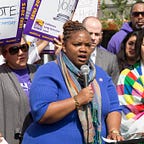It’s Time to Hold Nursing Homes Accountable — Here’s How We Start
It is imperative that California become a leader in nursing home reform. AB 1695 will be the first step towards that goal.
Thousands of people reside or receive care in the over 1,200 skilled nursing facilities (SNFs) located throughout California, but most may not be aware of just how easy it can be for someone to take over the license and/or operations of a SNF. It may be surprising to some that changes in ownership occur frequently and without notice, and often times a license will be pending for months or even years, before it is approved or denied by the California Department of Public Health (CDPH).
The current process for a change in ownership, also known as a CHOW, does not dictate a time frame in which CDPH must act on a pending application, nor does it require the residents or their family members be notified of these potential changes that have very real impact on the lives of nursing home residents and workers alike.
Nursing home operators have taken notice of the loopholes in the system and have used them to their advantage for decades. Shlomo Rechnitz, the largest nursing home operator in California, has 18 SNF CHOW applications that have been pending since 2015 (although the typical processing time is anywhere from 6 months to over a full year — a bloated timeline which is no doubt affected by nursing home organizational complexities and non-transparency). Mr. Rechnitz is using the seller’s license to be able to operate the facilities while CDPH is reviewing his applications.
To make matters worse, nursing homes often use complex management relationships that partition off various aspects of operations, administration, licensure, and ownership. These layered management relationships raise key questions for surveyors, workers, residents, consumer advocates and union representatives as well as other stakeholders: Who manages or supervises employees and their working conditions? Who directs care and holds responsibility for the quality of its delivery? With whom do we enforce quality standards, collective bargaining agreements, wage and hour laws, or charge as responsible for residents’ well-being or the failure to ensure it?
Currently, no prior notice of changes in ownership are required to be sent to CDPH, workers, residents, or anyone. In most cases, the change of ownership is disclosed to CDPH while the process of changing hands is already underway, leaving little time for workers or residents to prepare for what the shift may entail. In some cases, a facility will begin to be managed by another entity, through an incoming new owner or an interim agreement, well before any notice is sent to the department to finalize the change. This creates a lapse in oversight with regard to who is running California’s nursing facilities at any given time. It presents a problem for union workers when a grievance arises, when paychecks are late, or when their jobs are on the line. For residents, they can be subject to abrupt changes in how the facility is run, or suddenly see turnover of staff they’ve been receiving care from with little to no notice.
AB 1695 by Assemblymember Wendy Carrillo is currently on Governor Newsom’s desk in Sacramento, with a goal of addressing some of the key problems that the CHOW process presents. The bill would require more transparency and foresight regarding changes in ownership notification, which includes clarifying the types of nebulous management relationships used to undercut the change of ownership disclosure and approval requirements. A 90-day pre-notice of the pending change would be required to be posted at the affected nursing home, as well as on CDPH’s website for the public to view.
Just as important, the bill also establishes a minimum period of 60 days to retain current staff, which would codify some stability in whatever transition that may take place. This allows workers to plan ahead, have some job security, and for residents to experience continuity in care and plan ahead for their future, with pertinent, up-to-date information available to them regarding whose care they’re residing under.
It is imperative that California become a leader in nursing home reform, with AB 1695 being the first step toward that goal. We still have a long way to go to fully reform the CHOW system in the nursing home industry, but given our state’s size and rapidly aging population, we must set an example for how we transform our long-term care system; the lives of millions of people depend on it.
Tell Governor Newsom: Sign AB 1695 to Protect Skilled Nursing Facility Residents and Caregivers.
